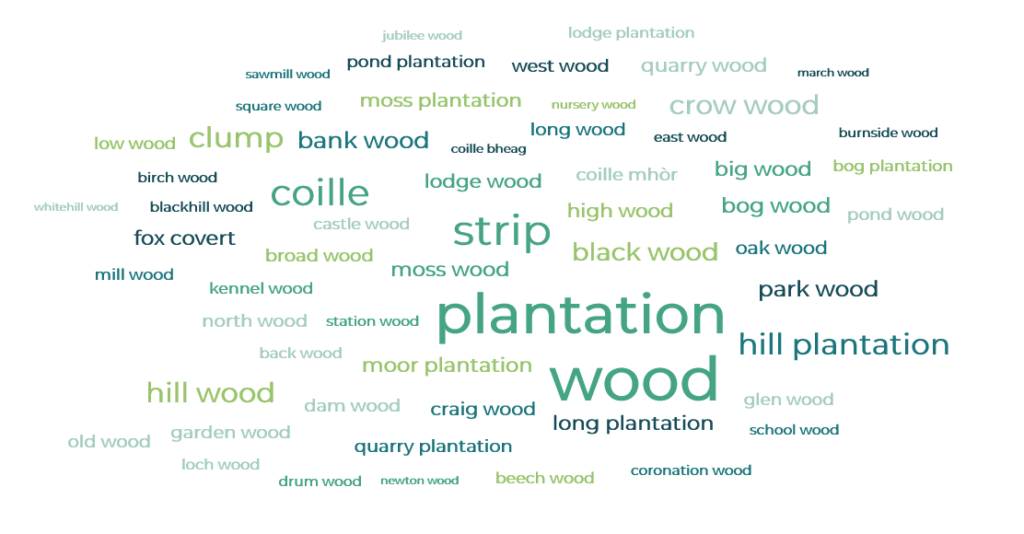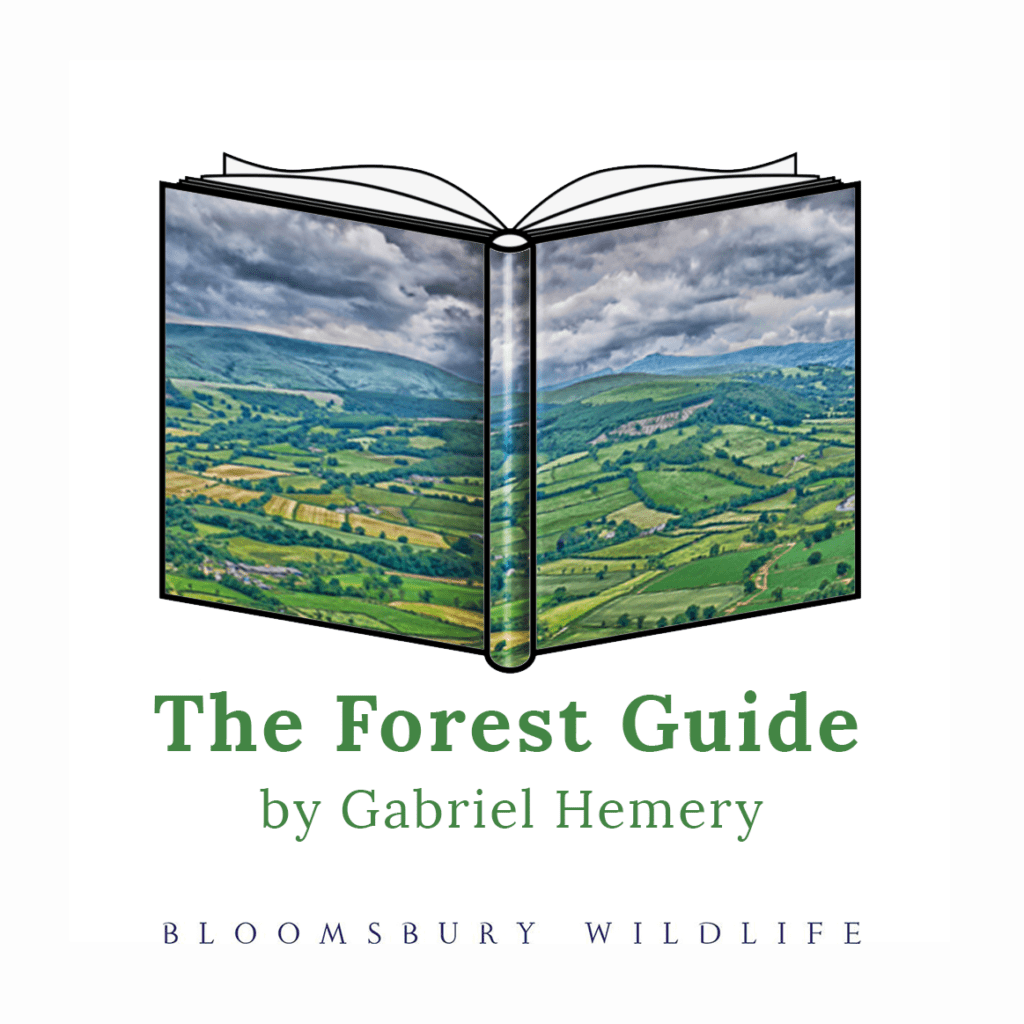From Aaron Hole to Zigzag, Britain is blessed with an amazing variety of names for its copses, woods, and forests.
According to the Ordnance Survey, there are some 98,000 named woodland sites in Britain. The most common noun found in British woodland names is unsurprisingly wood, followed by plantation, strip, coille (Scottish Gaelic for forest), and clump.

I’ve been looking into woodland names as part of my research for my next book The Forest Guide. I’ve compiled a ranked list of the top 50 woodland names (see Table) and later explore some of the more interesting, hilarious, and intriguing names, from Fireskull Copse to Whores Plantation, and Stinking Wood to Deadmans Copse.
| Woodland Name | Count | Rank |
| Long Plantation | 285 | 1 |
| The Grove | 227 | 2 |
| Park Wood | 208 | 3 |
| The Rookery | 205 | 4 |
| Crow Wood | 198 | 5 |
| New Plantation | 191 | 6 |
| Spring Wood | 183 | 7 |
| High Wood | 179 | 8 |
| The Belt | 173 | 9 |
| Long Wood | 170 | 10 |
| Round Wood | 145 | 11 |
| Big Wood | 139 | 12 |
| Black Wood | 138 | 13 |
| Great Wood | 132 | 14 |
| The Wilderness | 130 | 15 |
| Little Wood | 130 | 15 |
| Mill Wood | 127 | 17 |
| The Plantation | 120 | 18 |
| Oak Wood | 115 | 19 |
| West Wood | 114 | 20 |
| The Warren | 101 | 21 |
| North Wood | 98 | 22 |
| Home Wood | 96 | 23 |
| Long Copse | 95 | 24 |
| Black Plantation | 89 | 25 |
| Birch Wood | 89 | 25 |
| Low Wood | 88 | 27 |
| Ash Plantation | 88 | 27 |
| Lodge Plantation | 87 | 29 |
| New Covert | 83 | 30 |
| Quarry Wood | 82 | 31 |
| Jubilee Plantation | 82 | 31 |
| Fox Covert | 78 | 33 |
| Castle Wood | 76 | 34 |
| Lodge Wood | 74 | 35 |
| Church Wood | 73 | 36 |
| Park Plantation | 71 | 37 |
| Hall Wood | 68 | 38 |
| Old Wood | 66 | 39 |
| Beech Wood | 66 | 40 |
| Hagg Wood | 61 | 41 |
| Garden Wood | 61 | 41 |
| Church Plantation | 61 | 41 |
| Home Covert | 60 | 44 |
| Hill Plantation | 60 | 44 |
| Quarry Plantation | 59 | 46 |
| East Wood | 59 | 46 |
| Bank Wood | 59 | 46 |
| The Oaks | 58 | 49 |
| Round Copse | 57 | 50 |
Wildlife is an inspiration for many woodland names, including six variants of Wrens and 49 Woodcocks, a couple of Titcombe Woods, 23 Rookery plantations, and four Herons, but none can top the wonderful Woodcock Air or Upper Owlers Wood. Fox, Badger, Rabbit, Hare, and Boar are common too, including the fearsome sounding Boarpit Rough, but surprisingly there are only 11 Squirrels and one Marten, while two instances of Cod only boggle the mind. Flourishing alongside Flowerbank Wood and Flower’s Copse are 39 Primroses, 20 Bluebells, and nine Daffodils. Unsurprisingly, tree names are extremely common, while the popularity of a name appears to match the species’ rarity, with just 80 woodlands named after Yew trees, including Yewtree Knob and Yew Ring, 36 Hollys, and just three Chequers (another name for the wild service Sorbus torminalis).
Wonderful and confounding names abound immediately at the start of the A-Z list with Aaron Hole Plantation, while at the end of the long list, shortly before eight instances of Zigzag, a disproportionate number of curiosities appear with Whale Jaw’s Plantation, Widow Knight’s Copse, Whores Wood, Woofa Plantation, Wormstile Wood, Worth Nothing Plantation, Yawthorpe Fox Covert, and Yonder Brake.
Some of my other personal favourites include Cocked Hat Plantation, Kissing Copse, Sneckyeat Plantation, and Stinking Wood. Murder and death are never far away with 14 Deadmans and an equal number of Hangmans, plus three Robbers, and single culprits of Daggers Copse, Fireskull Copse, and Foulshotlaw Plantation. Mercifully, the needy might find solace in Robin Hood’s Howl.
Christian names abound as woodland names for both sexes, while I was pleased to discover a lonely Gabriel’s Copse in Hampshire. We can only suppose that many of these will have been named after specific individuals, most likely in remembrance.
Britain’s history is captured forever in its place names. Three sites are named Evelyn, perhaps inspired by the father of British forestry John Evelyn (1620-1706) although equally they might may refer to the feminine Christian name. More than 130 sites are named Jubilee, and there are 30 Coronation Plantations, and only the age of oldest trees might reveal which royal person they were planted to commemorate. Famous woodland historian and ecologist Oliver Rackham (1939-2015) argued that woodlands in Britain changed remarkably little after Norman conquest, at least until the advent of the 20th century. The previous use and purpose of our woodlands are often remembered in their names.
When I was researching for this article—a cold, dark and wet winter’s day—I found myself dreaming of spring and imagining a visit to Sunnyside Plantation and Warm Wood.

What is your favourite woodland in Britain? Do you own a woodland? Visit my dedicated website to contribute to my next book series: The Forest Guide
 This work is licensed under a Creative Commons Attribution- NonCommercial- NoDerivs 3.0 United States License.
This work is licensed under a Creative Commons Attribution- NonCommercial- NoDerivs 3.0 United States License.

Lovely post. I saved it as the names are so pretty.